T+A DAC 200
R120,000.00
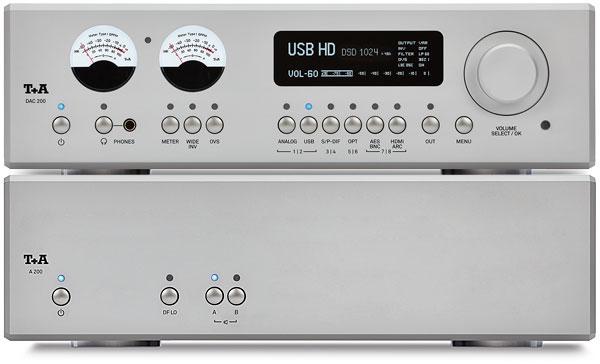
 Now a full quartet, T+A’s compact but beautifully formed Series 200 has expanded to include a media player, DAC/preamp and Purifi Eigentakt Class D stereo power ampSiegfried Amft, founder and MD of T+A, declares the intent of the brand’s Series 200 is to ‘combine the appearance of a Midi system with a high-end performance’. Midi, of course, is a word that evokes memories of 1980s/’90s hi-fi, so I’m surprised to see the term attached to a range that’s rather more aspirational in its technology. You might think something has been lost in translation, T+A being a German manufacturer, until you lay eyes on the DAC 200 and its button-heavy compact chassis. From the appearance side, at least, the ‘Midi’ mission has been accomplished.
Now a full quartet, T+A’s compact but beautifully formed Series 200 has expanded to include a media player, DAC/preamp and Purifi Eigentakt Class D stereo power ampSiegfried Amft, founder and MD of T+A, declares the intent of the brand’s Series 200 is to ‘combine the appearance of a Midi system with a high-end performance’. Midi, of course, is a word that evokes memories of 1980s/’90s hi-fi, so I’m surprised to see the term attached to a range that’s rather more aspirational in its technology. You might think something has been lost in translation, T+A being a German manufacturer, until you lay eyes on the DAC 200 and its button-heavy compact chassis. From the appearance side, at least, the ‘Midi’ mission has been accomplished.
This £4990 DAC/preamp is one of three new models in T+A’s Series 200, alongside the £3490 A 200 power amp and, to be reviewed anon, the £3990 MP 200 ‘multi-source player’ (CD, network, radio, Bluetooth, etc). Nearly two years ago the range launched with the £6600 HA 200 headphone amp [HFN Aug ’20], and that model’s smart styling and exemplary build quality is maintained. All four Series 200 components are the same size and shape, 32cm wide and 10cm high, and offered in black or silver anodised aluminium.
Sibling Rivalry
Beginning with the new DAC, there’s plenty of overlap between it and the headphone amplifier (not least the presence of a headphone output on the DAC 200 itself), and both have the same mix of superb flexibility tempered with one omission. Specifically, those Ethernet sockets that tease network playback only handle system control, and USB playback is solely from a computer/music library via USB-B (the USB-A socket is for charging an external device). Network/HDD playback features are the preserve of the MP 200, and likely the company is hoping that some customers will opt for a triple-model system of an A 200, DAC 200 and MP 200, for approximately £12,500.
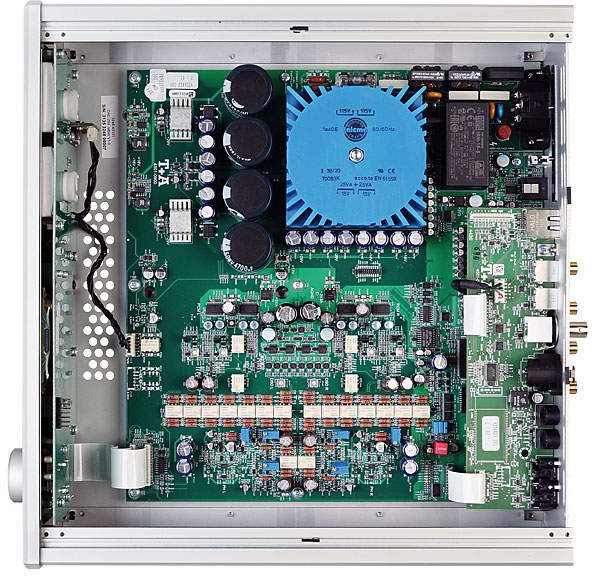
A further similarity between the HA 200 and DAC 200 is the split LPCM/DSD processing, T+A opting for a separate ‘two DACs in one box’ approach. LPCM inputs up to 768kHz/32-bit are served by a quartet of Texas Instruments DACs while DSD sources are routed to T+A’s custom ‘True 1-bit DSD converter’ for native delivery up to DSD1024/49MHz (via a Windows PC running an installed driver; for Mac users, the USB-B input maxes out at DSD256). The DAC also brings a six-strong lineup of digital filters and a proprietary ‘De-Jitter Masterclock’. The latter is a microprocessor-driven, multi-stage approach that combines precision 44.1kHz- and 48kHz-centric oscillators with a secondary PLL circuit to minimise timing errors before PCM conversion.
Purifi Power
Meanwhile, digital and analogue sections, including the power supplies, are galvanically separated by ‘ultra-fast’ isolators from Silicon Labs, while the Class A preamp section is fully discrete. Back panel inputs are – lack of networking accepted – comprehensive and include AES/EBU, optical and coaxial (BNC and RCA), and the aforementioned USB. There’s also an analogue RCA input, in addition to balanced XLR and unbalanced RCA outputs. For £480, you can add a two-in, one-out HDMI board.
The second part of our system, the A 200 amplifier, is a balanced Class D design, utilising the Purifi Eigentakt technology debuted in NAD’s M33 and C 298 models [HFN Aug ’20 & Oct ’21]. Power output is conservatively rated at 2x125W/8ohm. The amp modules work in conjunction with T+A’s Intelligent Safe Control monitoring/protection, plus voltage stage circuitry trickled down from its flagship HV Series amps [HFN May ’17].
Pairing the A 200 and the DAC 200 takes up little space, and, depending on your source hardware, getting them up and running should take little time. Only the neat, brushed metal FM200 remote is a potential speed bump, for while snug in the hand using it is far from intuitive. Buttons include the obvious (volume, settings) and the obscure. For example, what might two emoji-style faces – one happy, one sad – signify? Read the manual and you’re none the wiser, although it does at least tell you how to change filter settings, select different modes for the DAC’s front-panel meters, tweak balance and more. The bold, crisp display is also very informative.
![]() Master Class
Master Class
As a duo, T+A’s A 200 and DAC 200 dovetail together as slickly in terms of performance as they do visually. Their strengths are complementary, the DAC hardware adding a feeling of impressive detail and tonal mastery to the power amp’s purposeful, controlled demeanour, so the experience is one of listening to a system rather than two boxes. That said, I felt it was the DAC that was doing more of the heavy lifting, its ability to sweeten even plain vanilla CD/44.1kHz files being a notable trait. Overall, the voicing tends toward smooth in the upper registers while avoiding excessive warmth in the bass, and pin-sharp soundstaging is assured.
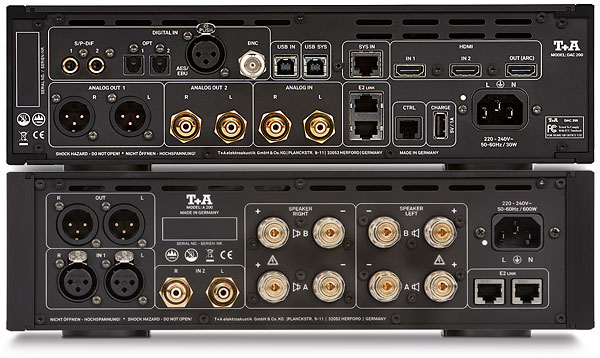
‘Leaving Trunk’, from Taj Mahal’s self-titled debut album [Columbia], was delivered as a 44.1kHz/16-bit stream via Tidal from a USB-connected Apple MacBook. It’s a track typical of the musician, being all foot-tapping blues rhythms and throaty vocal, and the T+A pair gave it the white-glove treatment.
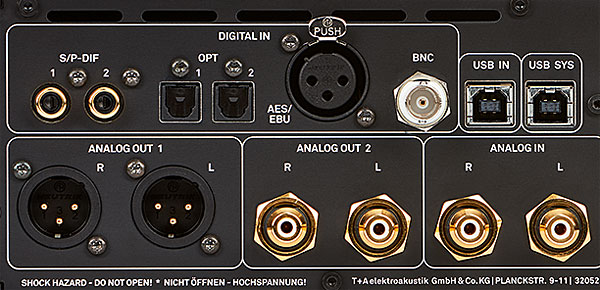
There was a precise feel to its portrayal of instrumental textures – harmonica served with a cool blast of air, hi-hat work pleasingly distinct – but all were blended so well together that the overriding urge was just to sit back and enjoy. The bass on this song, while focused in the middle of the stereo image, felt a little shy, even though the likes of CSNY’s ‘Helpless’ [CSNY 1974, Rhino Records; 96kHz/24-bit] shone a more favourable light on the system’s low-end handling and the potency of the A 200. This may not be the most belligerent power amplifier I’ve come across, trading exuberance for poise, yet it still mined low-end details obligingly, and without overemphasis.
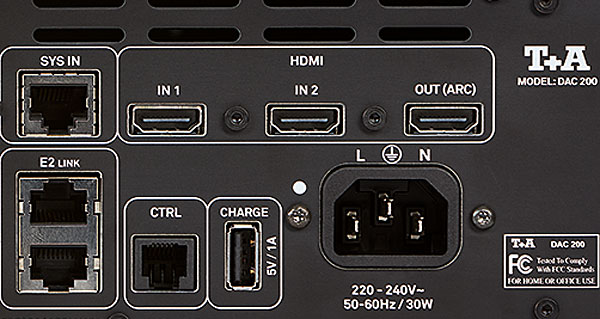
Filter Fiddling
Wrestling with the DAC 200’s digital filter selection, I was surprised to discover this was one device where I arrived at a preference (expecting, as usual, to leave non-plussed). Both the FIR options, to my ears, sounded more balanced than T+A’s in-house Bezier filters, with ‘FIR 2 (FIR Short)’ giving a marginally fuller feel to the ’70s supergroup’s live antics. In short, a brief sojourn into the DAC’s options is recommended more than usual.
Even with this preferred sound signature coaxed by the slow roll-off FIR filter, the T+A pairing showed no inclination to give me a big, warm hug, however. Midband and upper-bass information was uncoloured, leading to a sound that I imagine some might find a little ‘dry’. The benefit of this, though, was a feeling of accuracy from top to bottom, and a steely, lean low-end that worked wonders with the disco-infused backing to Blue Oyster Cult’s ‘Fire Of Unknown Origin’ [eponymous, Columbia; 96kHz/24-bit].
Handling Handel
Bach’s Chromatic Fantasia and Fugue… BWV 903, played with finger-blurring skill by pianist Christian Grøvlen [2L; DSD256 download], is a piece of undulating tempo and dynamic peaks and troughs, all conveyed by one instrument. The Series 200 models tackled it admirably, sounding airy, light and soft when needed, but still with an undercurrent of innate strength to give force to Grøvlen’s key-work – it was easy to imagine the performance taking place in front of me as sustained notes decayed into a large acoustic.
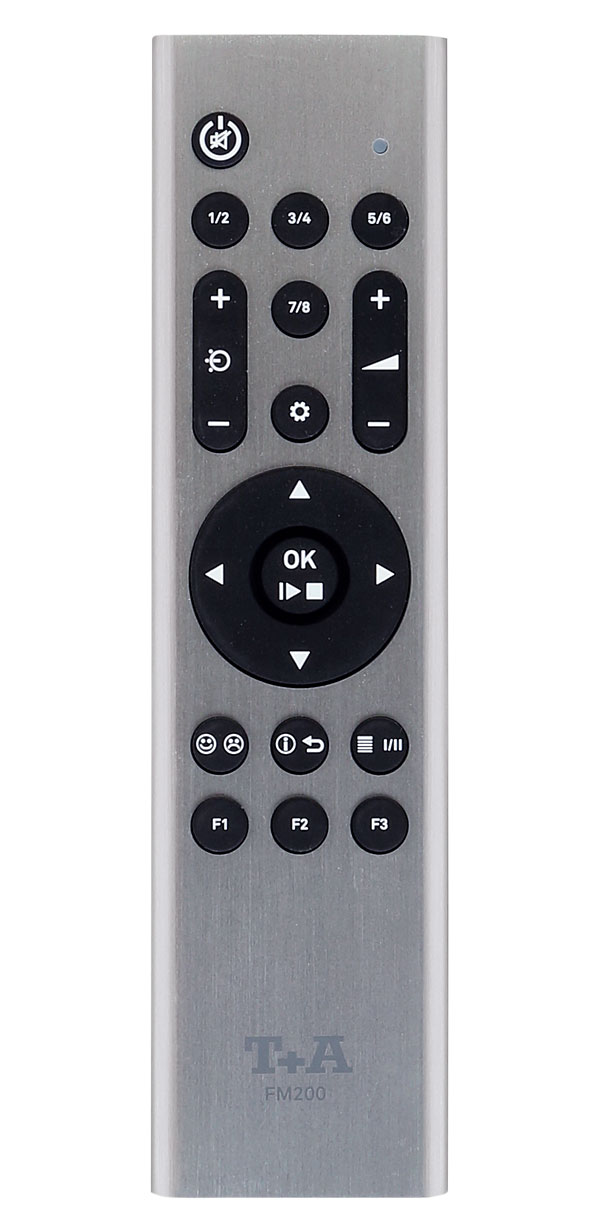
This effect was repeated, with a full orchestra, on the London Royal Philharmonic’s performance of Handel’s Water Music suite [HMV Concert Classics; 44.1kHz/16-bit download] as the DAC 200 deftly marshalled strings, timpani and brass, again showing a knack for delicacy of resolution and fluency.
Here the A 200 amp put in an unshowy, authoritative performance, demonstrating both power and civility while working comfortably at a high listening level hooked up to a pair of floorstanding speakers. Even though, I might add, its form factor screams ‘bookshelf!’.
However, combined with the notched digital volume control of the DAC 200 giving a smooth progression from ‘background at a dinner gathering’ to ‘let’s get this party started’ levels, this combined system isn’t one that has to be driven hard to sound its best – T+A’s sumptuously detailed, neutral sound plays equally well on the quiet.
Hi-Fi News Verdict
While avoiding any lame jokes about ‘German engineering’, I’m bound to say there’s a wonderful sense of synergy – and not just in build and style – between these two T+A components. The A 200 is a mature-sounding power amp with excellent driving ability, and a perfect partner for the DAC 200’s refined, insightful and light-footed approach. Yes, there’s no networking, but the Series 200 has this covered elsewhere…
T+A has set the bar extremely high with the DAC 200. This DAC is one for the ages. It sounds fantastic, looks classic, functions seamlessly, is well supported, and is priced competitively. Based on my listening habits and experience with more DACs than I can remember, this would be my number one choice for a DAC anywhere near the DAC 200’s price. Everything about the DAC 200 is just that good. Period.
The T+A DAC 200 is so good, it brought me back to two channel stereo listening, from my one of a kind 7.1.4 Atmos system, and figuratively glued me to my chair. I’m enthralled with the music coming from my system, through the DAC 200. Given that my immersive system is capable of truly amazing performance, T+A is doing more than a few things right with the DAC 200.
The first time I was dramatically drawn back to my two channel system, I was listening to Lady Blackbird’s album Black Acid Soul. On tracks such as Five Feet Tall, and It’ll Never Happen Again, Lady Blackbird just reached out through my Wilson Alexia speakers, grabbed me by the collar, and made me sit up straight in my listening chair. What I heard was so full of emotion, effort, and talent that I had to run my warm hand up and down my arm as the goosebumps sent a chill through my body. The DAC 200 pulls incredible music and performances from ones and zeros, like nothing in its class.
Let’s dig into what makes the DAC 200 tick, before going further about its stellar performance.
T+A DAC 200 Details
The DAC 200 has a long list of meaningful features that don’t just check a box for the consumerist with a spreadsheet. These are A List features for music aficionados that set this DAC apart from the competition. The most impactful of these features is the T+A Path Separation Technology. According to T+A, “Both PCM and DSD have their own converter, specifically tailored to their requirements … For PCM signals we use our quadruple converter, whereas DSD files are processed using the T+A True 1-bit converter, which is unique in the world.” The DAC 200 is literally two digital to analog converters in one chassis. It’s the best of both worlds, without the requirement of purchasing two DACs and all the headache that would follow, when one needs to switch DACs between playing PCM and DSD. The DAC 200 reads the input signal and routes the audio accordingly.
T+A offers four different filters for internal upsampling in the DAC 200. If I had to guess, I’d say most DACs on the market don’t offer manual filter selections. T+A prefers to give the listener options. The options are FIR 1 for extremely linear frequency response, FIR 2 for improved peak handling, BEZ 1 for Bezier interpolation and IIR filtering, and the BEZ 2 pure Bezier interpolator for “perfect” timing and dynamics. One great aspect of these filters is that there’s no wrong choices. It’s all about personal preference.
Those who prefer non-oversampling (NOS) DACs because they like to use an application such as HQPlayer to upsample externally, are also in luck. The DAC 200 features two crucial pieces of this puzzle. First, it offers two different NOS modes. The difference between the modes is a low pass filter setting of 120 kHz or 60 kHz for 1x sample rate material. Second, the DAC 200 accepts ultra high sample rates up through 768 kHz PCM and DSD1024. High sample rate inputs are critical for those who upsample externally.
 Based on my extended listening through the DAC 200, the best sound in my system was achieved using HQPlayer to upsample all audio to DSD256, using poly-sync-gauss-long (1x), poly-sync-gauss-hires-lp (2x), and the ASDM7ECv2 modulator. If there was a “right” filter and modulator, there would be no choices available in HQPlayer. However, filter and modulator selection are all about personal preference, whether done externally or inside the DAC.
Based on my extended listening through the DAC 200, the best sound in my system was achieved using HQPlayer to upsample all audio to DSD256, using poly-sync-gauss-long (1x), poly-sync-gauss-hires-lp (2x), and the ASDM7ECv2 modulator. If there was a “right” filter and modulator, there would be no choices available in HQPlayer. However, filter and modulator selection are all about personal preference, whether done externally or inside the DAC.
Similar to the T+A Path Separation Technology in concept, is the T+A Digital Analogue Separation System inside the DAC 200. This, “Utilizes ultra-fast digital isolators from Silicon Labs to provide galvanic separation between the analogue and digital sections. … the mains sections for the analogue and digital signal paths are also completely separated galvanically.” Takign this a step further, the timing critical clocking signals for the D to A converters are isolated using special high frequency impulse transformers to insure jitter free performance, that is unobtainable using integrated isolators. As readers can see, separation is a big deal to the T+A engineering team, and it should be a big deal for music lovers who care about sound quality.
On the outside, the DAC 200’s design is elegant and technical at the same time. There are quite a few physical buttons, to access that which needs quick accessing, but they look nice and have a solid feel. The volume control features satisfying detents as it’s rotated, and also has a very solid feel. The front display is large enough to be useful from the listening position, to see the selected input and current sample rate. However, the other items are quite small and require the listener be up close and personal with the DAC 200.
The stars of the front panel show are clearly the analog meters. The T+A engineering team hit a home run with these on many levels. Of course they look really nice and contribute to the “audio fireplace” effect. But, T+A took them even further by enabling the meters to work in three different modes, each selectable by the listener. The meters can operate in a more traditional VU scale monitoring the input or output level, display the temperature of the entire system and output stages separately, or display the quality of the incoming audio stream. According to the DAC 200 manual, “The left meter [scale – 0 +] shows whether the clock frequency of the incoming data stream of the currently active source is operating at the standard frequency. If the needle is exactly in the middle of the scale, the frequency of the source is exactly at the standard frequency. The display range covers -150ppm to +150 ppm. Digital sources complying to the standards should be in the range +/- 50ppm. The right meter [scale 0…100] indicates the error rate of the currently active input. With good transmission quality, the display should be at 0.”
Both internally and externally, the T+A engineering team has done a marvelous job pairing form and function, with the main goal of accurate music reproduction.
Back To Listening
Getting back into listening mode, I spent time using the DAC 200 in different digital configurations. I settled on two different sources. One, a custom built SOtM computer using the new SOtM sMB-Q370 Motherboard, PCIe USB card, Ethernet card, clocking add-ons and power supplies all supplied by SOtM. Two, my stalwart Sonore signatureRendu SE Optical running NAA software. These sources and HQPlayer Embedded came together to create a really special sound.
 Listening to Esa-Pekka Salonen conducting the Los Angeles Philharmonic in Le Sacre du Printemps, really enabled the DAC 200 to shine in multiple areas. The best of those was reproduction of percussion, from tiny cymbal details to texture on drumheads to booming thunder-like strikes. Through some components we get either texture or boom, with one precluding the other. Not so, through the DAC 200. I heard it all with great detail and transients and power. I listened to Night On Bald Mountain several times through the DAC 200, each time as enjoyable as the previous one. The DAC 200 never disappointed.
Listening to Esa-Pekka Salonen conducting the Los Angeles Philharmonic in Le Sacre du Printemps, really enabled the DAC 200 to shine in multiple areas. The best of those was reproduction of percussion, from tiny cymbal details to texture on drumheads to booming thunder-like strikes. Through some components we get either texture or boom, with one precluding the other. Not so, through the DAC 200. I heard it all with great detail and transients and power. I listened to Night On Bald Mountain several times through the DAC 200, each time as enjoyable as the previous one. The DAC 200 never disappointed.
Using the same track, but switching to the DAC 200’s built-in Bezier filters and sending the DAC bit perfect 24/96 PCM audio, one could her an equally engaging performance with nuance and detail, but it was just a skosh softer than HQPlayer and DSD256. External upsample is the icing on the cake, while the cake is delicious in its own right. Listeners uninterested in external upsampling should consider this DAC a 10 out of 10, with the ability to go to 11 via HQPlayer if necessary.
 Moving back to HQPlayer upsampling to DSD256 on the SOtM computer, I played Greg Brown’s album Honey in the Lion’s Head. On the track Who Killed Cock Robin, I could smell Brown’s coffee and cigarette laden breath. I don’t know if he smokes or drinks coffee, but I won’t let that ruin a perfect illusion brought on by such realistic audio reproduction through the T+A DAC 200. This track, and entire album, has a pure and organic realism through the DAC 200, that just isn’t present in many competitive DACs. I was listening to tracks that I’d typically skip, because the sound was so good. This isn’t a case of listening to music only because it sounds good, but rather, letting oneself be exposed to new music initially because of the sound, and realizing afterward that I was previously missing out on some really great music.
Moving back to HQPlayer upsampling to DSD256 on the SOtM computer, I played Greg Brown’s album Honey in the Lion’s Head. On the track Who Killed Cock Robin, I could smell Brown’s coffee and cigarette laden breath. I don’t know if he smokes or drinks coffee, but I won’t let that ruin a perfect illusion brought on by such realistic audio reproduction through the T+A DAC 200. This track, and entire album, has a pure and organic realism through the DAC 200, that just isn’t present in many competitive DACs. I was listening to tracks that I’d typically skip, because the sound was so good. This isn’t a case of listening to music only because it sounds good, but rather, letting oneself be exposed to new music initially because of the sound, and realizing afterward that I was previously missing out on some really great music.
Thanks to my 7.1.4 Atmos system, I’ve recently been exposed to some great prog rock. A new favorite of mine is the band Porcupine Tree and its album Closure/Continuation. Listening to the album in stereo is a very different experience, especially because band leader Steven Wilson’s enthusiasm for immersive audio and talent mixing in Atmos, has lead him to produce incredible surround albums.
 I was a touch nervous that the DAC 200 would fall flat when I listened to Porcupine Tree. Let’s be real, any stereo DAC has its hands and feet tied together when competing against a 12 channel immersive system, playing an album created with Atmos in mind. Listening to the two channel stereo mix of C/C, the track Harridan sounds great through the DC 200. From the opening bass intro to the hard hitting kick drums to the immensely powerful guitar riffs that kick in after a slight lull in the music around the 3:15 mark of the track. Any fault I could hear in the sound was completely unrelated to the DAC 200, and solely because I was comparing the Atmos and stereo mixes in my head. Overall, the DAC 200 delivered everything there was to deliver on this album, and nothing more. Speed, power, and detail were all there, when present on the recording. Just as they should be.
I was a touch nervous that the DAC 200 would fall flat when I listened to Porcupine Tree. Let’s be real, any stereo DAC has its hands and feet tied together when competing against a 12 channel immersive system, playing an album created with Atmos in mind. Listening to the two channel stereo mix of C/C, the track Harridan sounds great through the DC 200. From the opening bass intro to the hard hitting kick drums to the immensely powerful guitar riffs that kick in after a slight lull in the music around the 3:15 mark of the track. Any fault I could hear in the sound was completely unrelated to the DAC 200, and solely because I was comparing the Atmos and stereo mixes in my head. Overall, the DAC 200 delivered everything there was to deliver on this album, and nothing more. Speed, power, and detail were all there, when present on the recording. Just as they should be.
One activity I wish I could’ve done is compare the DAC 200 with the DAC 8 from T+A. I really liked the DAC 8, as I do much of what T+A designes. It’s solid engineering-based audio company that delivers on its promise. Going solely by memory, which is fraught with issues, I’d say the DAC 200 is in a completely different class from the DAC 8. It really isn’t a fair comparison. The DAC 200 is far better than the price difference between the two suggests.
Conclusion
 Many years from now, when T+A ceases DAC 200 production, this DAC will have an immediate cult following, and values on the used market will shoot up. This is one of those DACs that’ll be sought after for decades. It does so much, so right. It’s a product for which the CASH List was created. The DAC 200 is among the leaders, at any price, on our list of recommended hardware, and easily the leader among its peers anywhere near its $7,125 MSRP.
Many years from now, when T+A ceases DAC 200 production, this DAC will have an immediate cult following, and values on the used market will shoot up. This is one of those DACs that’ll be sought after for decades. It does so much, so right. It’s a product for which the CASH List was created. The DAC 200 is among the leaders, at any price, on our list of recommended hardware, and easily the leader among its peers anywhere near its $7,125 MSRP.
This DAC was designed to use its internal filters or take advantage of the great horsepower of an external upsampling computer running HQPlayer. Either way, the T+A DAC 200 delivers the goods. It’s a 10 out of 10 on its own, and an 11 out of 10 with the world class DSP from Jussi Laako’s HQPlayer.
After listening through the DAC 200 for a few weeks, using it with different sources, reading the user manual a couple times, and exchanging emails with the T+A team, I realized that T+A gets it. I’m willing to bet that many readers will immediately understand what “it” is, because they’ve also been immersed in this world of digital audio for many years and tried many different solutions in an effort to perfect their audio systems. T+A enables many of us to have the best of both worlds because the company gets it on so many levels, embraces cutting edge technologies, and has set a new standard for digital to analog conversion at a competitive price.
Well done T+A, well done.
Description
Design Principles
The Series 200 was developed with the goal of closing the supposed gulf between high-grade specialised individual devices – ‘separates’ – and a combined system for relaxed listening. And that’s why the Series 200 consists of now five units. The DAC 200 and HA 200 reference converter and pre-amplifier convert digital data into analogue signals, and constitute the heart of their system configurations: the DAC 200’s outstanding pre-amplifier and output stages make it the ideal core of a classic HiFi system with loudspeakers, whereas the HA 200 takes on a similar role in an audiophile headphone system. Thanks to its Modular High-End Architecture (MHA) the MP 200 operates as a universal unit capable of delivering all modern music sources, from DAB radio to streaming. The A 200 output stage, generating 250 Watts power per channel into 4 Ohms, provides incredible performance with superb linearity and outstanding measured values. Thanks to the advanced technologies employed, the A 200 is able to exploit its full performance regardless of load, i.e. independently of the loudspeakers to which it is connected. The M 200 combines the fine detail, resolution and detail dynamics of the A 200 stereo power amplifier with an output of more than 400 Watt. It is designed to feed just one loudspeaker, and this allows the M 200 to deliver music in a manner which is even more audiophile,more powerful and even more devoid of coloration than would ever be possible with a stereo power amplifier. Although all the Series 200 devices offer outstanding levels of performance individually, the aim of their development was to make them even better when used together in a system. The integral T+A Link System has been fine-tuned to meet the specific requirements of the Series 200, with the result that every device is as universal as possible, as well as keeping interference signals completely separate from the analogue signal path: this ensures that the music remains just as clear and precise as it was when the artiste performed it.
DAC 200
D/A Converter-Preamplifier
DSD: T+A True 1-Bit Converter, native Bitstream up to DSD 1024 (49,2 MHz)
USB Receiver conforming to UAC2 and UAC3 standards
„Non Oversampling“ DAC mode (NOS-DAC)
Frequency response + 0 / − 3 dB:
0,1 Hz – 200 kHz









